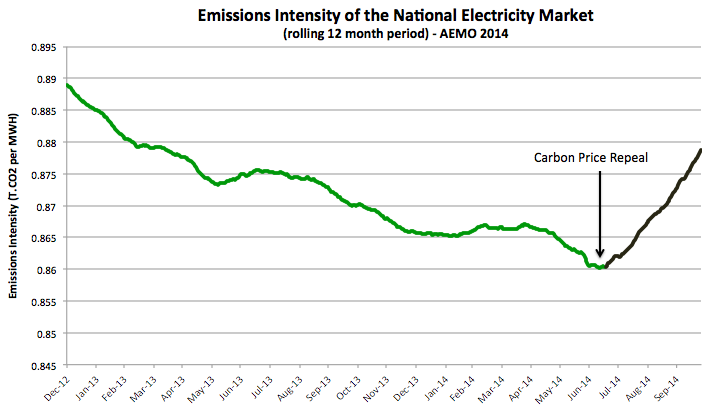
There's an nice article in NCSE Reports by John Abraham, John Fasullo and Greg Laden, titled
"Continued Global Warming in the Midst of Natural Climate Fluctuations," about the hiatus and all that. It's not very technical and would be a good thing for those who think the hiatus means no more global warming to read.
The first figure in the article (right) reminded me of something I've been wondering -- how sensitive are atmospheric trends to changes in the 93.4% number for the percentage of heat that goes into the ocean?
I think I can estimate it with some simplications. The answer is, if I'm right: surface and tropospheric temperature trends are
very sensitive to changes in ocean heating. Answer below (
in red), using some very basic physics that is a bit pedantic.
Let Q
in be the amount of heat coming into the Earth over some period of time. (So the units of Q
in are energy per unit time, whereas the symbol Q is usually used for just energy.) Let's assume in all goes either into the ocean or into the troposphere, so Q
in = Q
O + Q
t, where Q
O is the amount of the heat that goes into the ocean, and Q
t the amount into the troposphere.
Now consider two scenarios. In the first, the one we're living in, a fraction f1 (= 0.934) of the heat goes into the ocean, and in the second, a fraction f2 goes into the ocean.
So
QO,1 = f1Qin and QO,2 = f2Qin.
By assumption, the total amount of heat going into the Earth is the same, so
Qin = QO,1+ Qt,1 = QO,2 + Qt,2
where "t" stands for troposphere. A dash of rearranging and a smidgen of algebra gives
(f1-f2)Qin = Qt,2 - Qt,1
What is
Qin? It's
QO,1/f1. We know what f1 is: 0.934, from the figure. If we assume all the heat coming into the ocean goes into the 0-2000 m region (that's the top half of the ocean -- and
not a bad assumption), then
QO,1 can be estimated from
10-years worth of Argo data for that region. When I do that I get 0.93e22 J/yr.
That finishes the ocean part. For the troposphere
Q1 = mtctΔT1 and Q2 = mtct ΔT2,
where ΔT is the amount of temperature change from whatever the baseline is:
ΔT1 = T1 - Tbase and likewise for scenario 2. (Strictly speaking it's the change of temperature with time, viz. a trend, but as with Q above I'll just call it T.) Then
Qt,2 - Qt,1 = mtct (T2 - T1)
where we want to calculate the temperature difference as a function of f2.
Putting this all together then gives
T2-T1 = (1-f2/f1)QO,1/mtct
All this would surely look better if (1) I knew more HTML, and (2) I was using Wordpress, which has an equation-maker plug-in, but I don't and I'm not.
Now, what's the mass of the troposphere? About 80% of the total atmospheric mass, or 4.1e18 kg.
(Interestingly, you can calculate the atmosphere's mass without leaving your chair: m = PsA/g, where Ps is the surface pressure, A is the Earth's area, and g the acceleration due to gravity at the surface. Of course, g varies with altitude, but that's a small effect.)
Here ct is the troposphere's specific heat. I'll assume the troposphere is homogeneous throughout, and approximate its specific heat by the specific heat of air at typical room conditions and 40% humidity, which is
1,012 J/kgK.
Now we just calculate. If f2 = 0.935 -- that is, it's just 0.1 percentage points above f1 -- I find the difference in trends is
T2-T1 = -0.024°C/decade
which seems like it could be in the ball park. At least, it doesn't seem ridiculous. And the sign is right: more heat into the ocean means heat taken out of the troposphere, which lowers its temperature.
So a very small change in how much heat goes into the ocean can lead to noticeable changes in the temperature trends. If f2 is 0.5 percentage points above f1, then
T2-T1 = -0.12°C/decade
which could well put a damper on the greenhouse warming of a decade or two. So just a little more heat going into the ocean (relatively little -- it's still a huge number of Joules) can noticeably cool the troposphere. Or even more noticeably for the surface, which holds even less heat then the troposphere (for, say, the top 2 meters of air above the surface).
That's what I suspected, and the rough numbers seem to support that.








.JPG)
.JPG)




